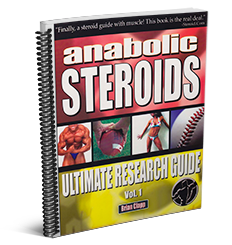this was taken from Marcus
I'm just doing some research on this and look what Ive found,
even after 4 days of exogenous gh your natural gh is still suppressed so if this is true you completely suppress your natrual production while your injecting daily anyway!!
(DAN) this is interesting and going against what I have read elsewhere, and on very low dosage also,
Changes in Non-22-Kilodalton (kDa) Isoforms of Growth Hormone (GH) after Administration of 22-kDa Recombinant Human GH in Trained Adult Males1
Jennifer D. Wallace, Ross C. Cuneo, Martin Bidlingmaier, Per Arne Lundberg, Lena Carlsson, Cesar Luiz Boguszewski, John Hay, Massoud Boroujerdi, Antonio Cittadini, Rolf Dall, Thord Rosén and Christian J. Strasburger
Metabolic Research Unit (J.D.W., R.C.C., J.H.), Department of Medicine, and Statistics Section, Department of Social and Preventative Medicine, University of Queensland, Princess Alexandra Hospital, Brisbane 4102, Australia; Neuroendocrine Unit (M.B., C.J.S.), Department of Medicine, Innenstadt University Hospital, 80336 Munich, Germany; Serviço do Endocrinologia e Metabologia do Hospital de ClÃnicas da Universidade Federal do Paraná (C.L.B.), 80060-240 Curitiba, Brasil; Research Centre for Endocrinology and Metabolism (P.A.L., L.C., T.R.), Sahlgrenska Hospital, Gothenberg, S-413 45 Sweden; Department of Endocrinology (M.B.), St. Thomas’s Hospital, London SE1 7EH, United Kingdom; Department of Internal Medicine and Cardiovascular Sciences (A.C.), Frederico II University, 80131 Naples, Italy; and Department of Medicine M (Endocrinology and Diabetes) (R.D.), Aarhus University Hospital, Aarhus, 8000 Denmark
Address all correspondence and requests for reprints to: Jennifer D. Wallace, Metabolic Research Unit, University of Queensland, Department of Medicine, Princess Alexandra Hospital, Brisbane 4102, Australia. E-mail:
jwallace@medicine.pa.uq.edu.au.
GH is being used by elite athletes to enhance sporting performance. To examine the hypothesis that exogenous 22-kDa recombinant human GH (rhGH) administration could be detected through suppression of non-22-kDa isoforms of GH, we studied seventeen aerobically trained males (age, 26.9 ± 1.5 yr) randomized to rhGH or placebo treatment (0.15 IU/kg/day for 1 week). Subjects were studied at rest and in response to exercise (cycle -ergometry at 65% of maximal work capacity for 20 min). Serum was assayed for total GH (Pharmacia IRMA and pituitary GH), 22-kDa GH (2 different 2-site monoclonal immunoassays), non-22-kDa GH (22-kDa GH-exclusion assay), 20-kDa GH, and immunofunctional GH. In the study, 3 h after the last dose of rhGH, total and 22-kDa GH concentrations were elevated, reflecting exogenous 22-kDa GH. Non-22-kDa and 20-kDa GH levels were suppressed. Regression of non-22-kDa or 20-kDa GH against total or 22-kDa GH produced clear separation of treatment groups. In identical exercise studies repeated between 24 and 96 h after cessation of treatment, the magnitude of the responses of all GH isoforms was suppressed (P < 0.01), but the relative proportions were similar to those before treatment. We conclude: 1) supraphysiological doses of rhGH in trained adult males suppressed exercise-stimulated endogenous circulating isoforms of GH for up to 4 days; 2) the clearest separation of treatment groups required the simultaneous presence of high exogenous 22-kDa GH and suppressed 20-kDa or non-22-kDa GH concentrations; and 3) these methods may prove useful in detecting rhGH abuse in athletes.
*Anyone wanting a source check from a willing





 Reply With Quote
Reply With Quote


